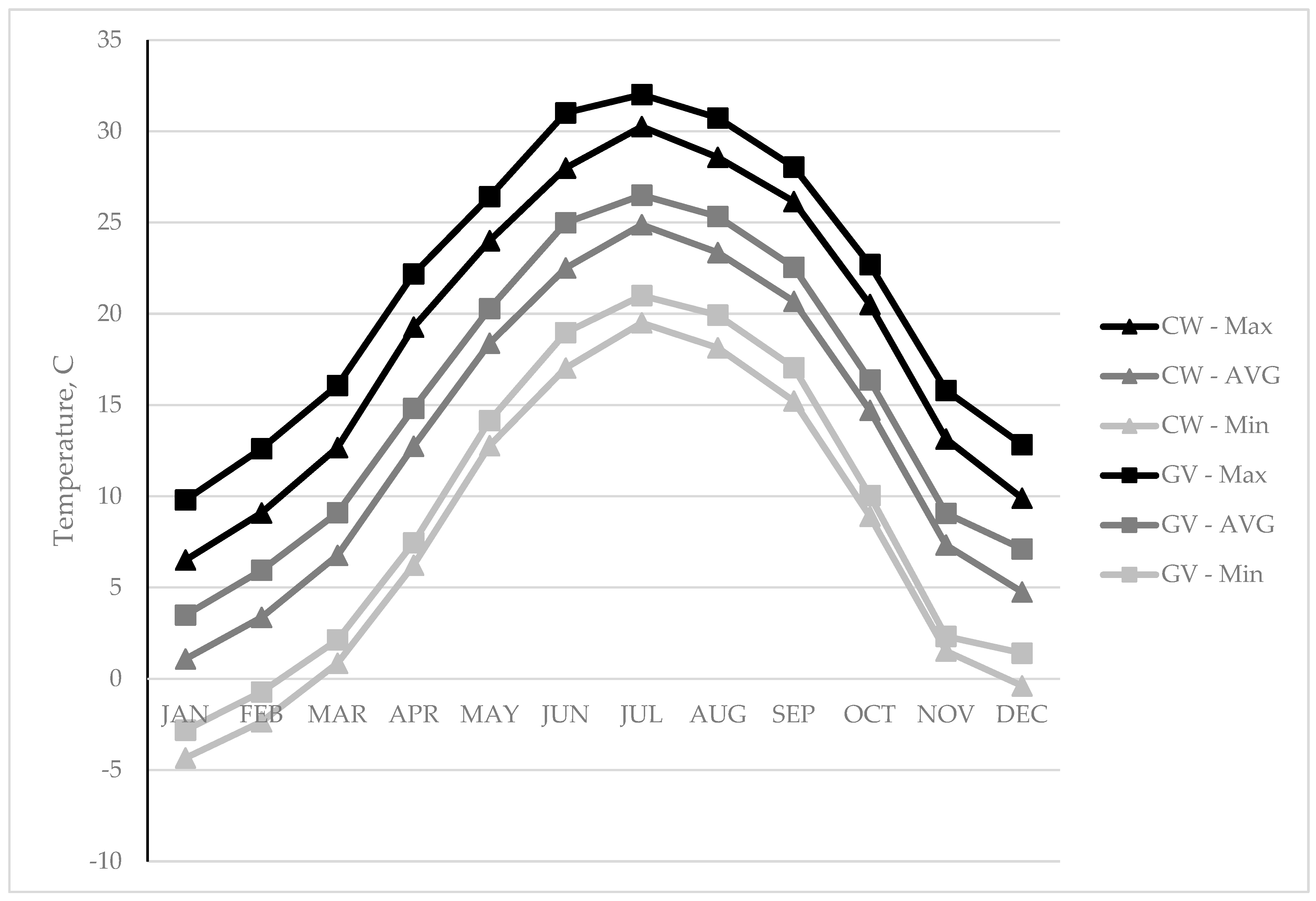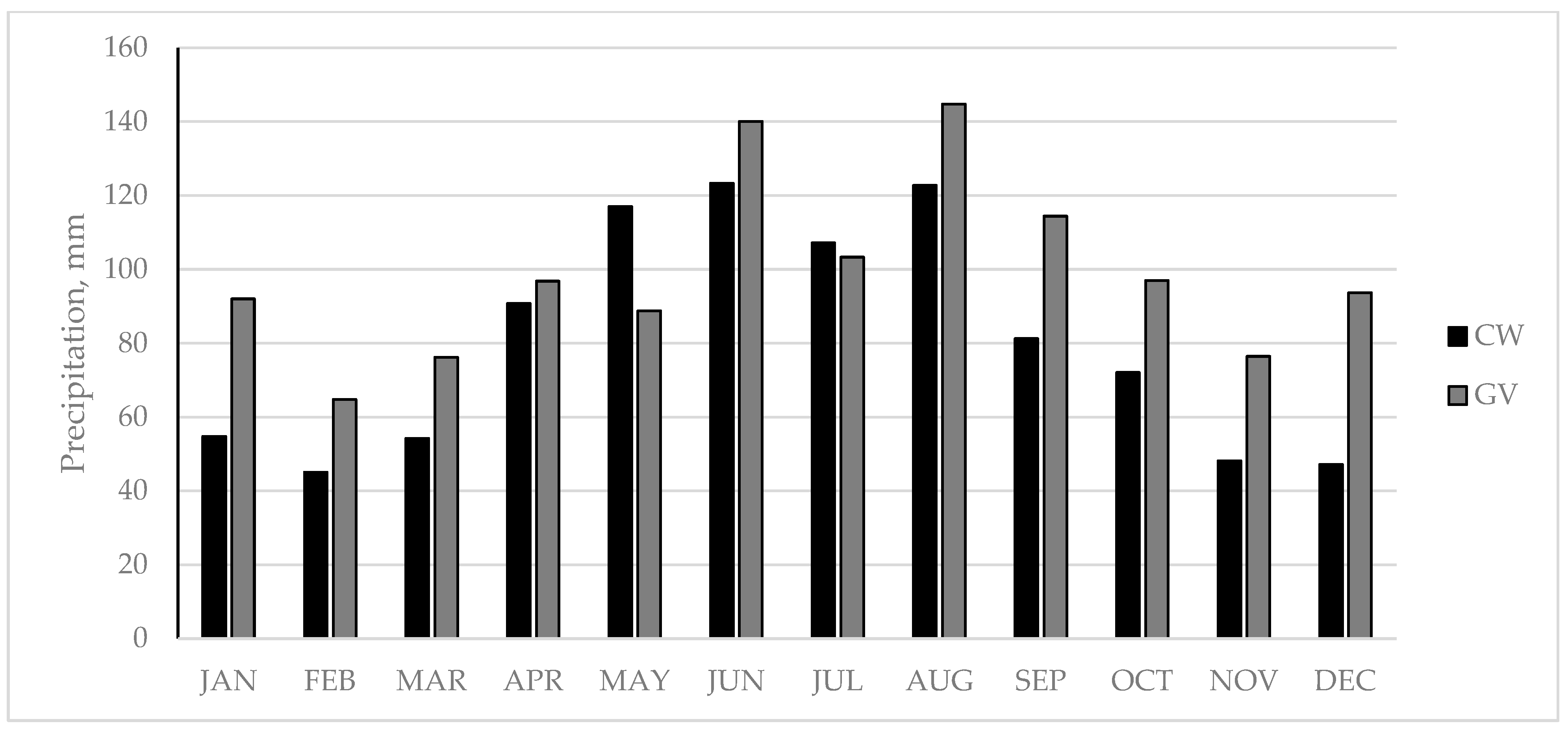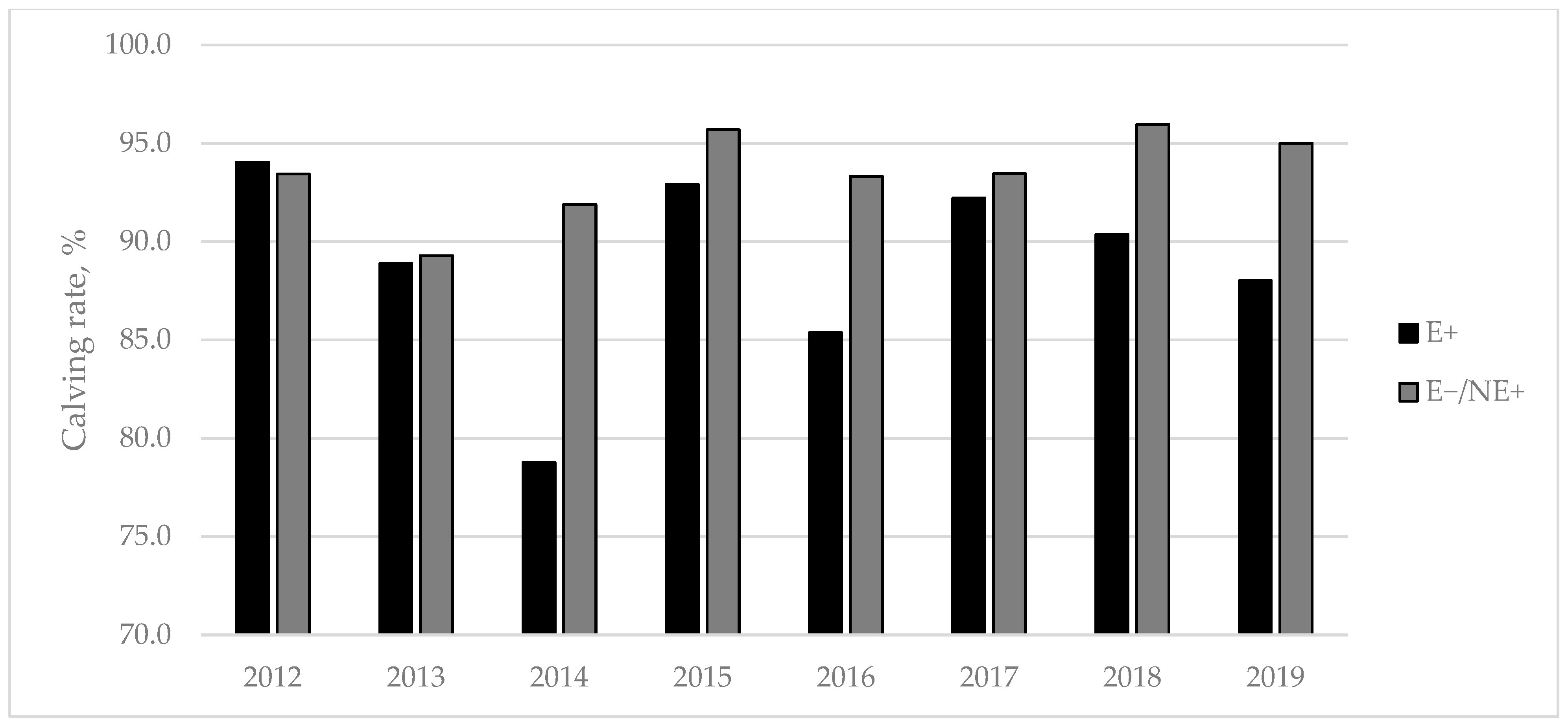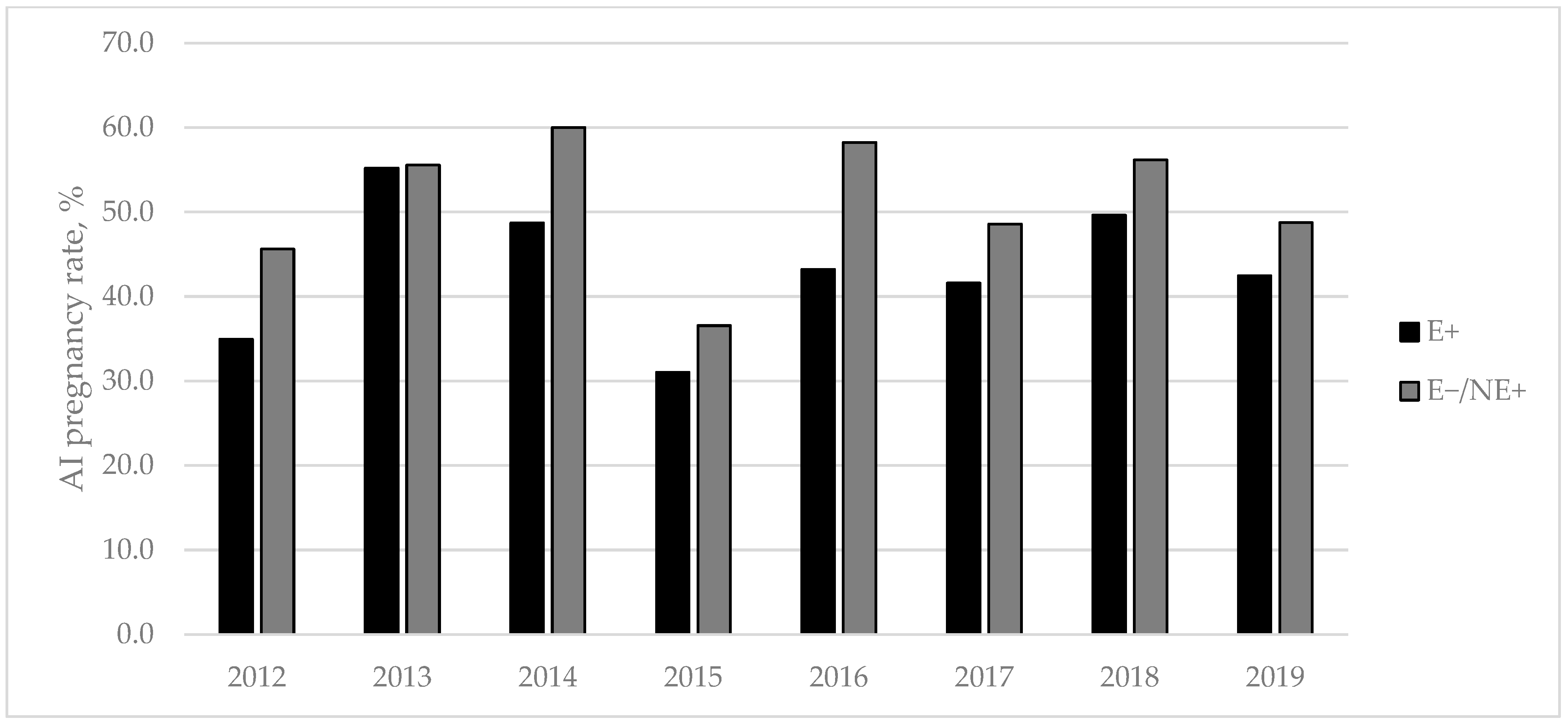The Effects of Endophyte-Infected Tall Fescue on the Production and Reproductive Performance Parameters of Beef Cattle and Calves †
Abstract
1. Introduction
2. Materials and Methods
2.1. Study Sites
2.2. Climatological Data
2.3. Cattle Performance Data
- -
- No identification or data entry present in the dataset.
- -
- The cow was brought to the farm mid-season as already bred.
- -
- The cow was not exposed via artificial insemination or natural service.
2.4. Weaning Weight Data Analysis
- -
- Died prior to weaning.
- -
- No identification or data entry present.
- -
- Sold prior to weaning.
- -
- Bottle-fed.
- -
- No weaning weight available.
2.5. Forage Sample Analysis
2.6. Statistical Analysis
3. Results
3.1. Climatological Data
3.2. Total Ergot Alkaloid Concentrations
3.3. Cow Weight and Condition and Calf Performance
3.4. Calving and Pregnancy Rates
4. Discussion
4.1. Birth Weight
4.2. Weaning Weight
4.3. Body Condition Score and Body Weight
4.4. Pregnancy Rate
4.5. Calving Rate
4.6. Climatological Data
5. Conclusions
Author Contributions
Funding
Institutional Review Board Statement
Informed Consent Statement
Data Availability Statement
Acknowledgments
Conflicts of Interest
References
- Christensen, M.J.; Voisey, C.R. Tall fescue–endophyte symbiosis. In Tall Fescue for the Twenty-First Century; Fribourg, H.A., Hannaway, D.B., West, C.P., Eds.; ASA-CSSA-SSSA: Madison, WI, USA, 2009; pp. 251–272. [Google Scholar]
- Stuedemann, J.A.; Hoveland, C.S. Fescue endophyte: History and impact on animal agriculture. J. Prod. Agric. 1988, 1, 39–44. [Google Scholar] [CrossRef]
- Patterson, J.; Forcherio, C.; Larson, B.; Samford, M.; Kerley, M. The effects of fescue toxicosis on beef cattle productivity. J. Anim. Sci. 1995, 73, 889–898. [Google Scholar] [CrossRef] [PubMed]
- Bacon, C.W.; Porter, J.K.; Robbins, J.D.; Luttrell, E.S. Epichloë typhina from toxic tall fescue grasses. Appl. Environ. Microbiol. 1977, 34, 576–581. [Google Scholar] [CrossRef]
- Nihsen, M.E.; Piper, E.L.; West, C.P.; Crawford, R.J., Jr.; Denard, T.M.; Johnson, Z.B.; Roberts, C.A.; Spiers, D.A.; Rosenkrans, C.F., Jr. Growth rate and physiology of steers grazing tall fescue inoculated with novel endophytes. J. Anim. Sci. 2004, 82, 878–883. [Google Scholar] [CrossRef] [PubMed]
- Caldwell, J.D.; Coffey, K.P.; Jennings, J.A.; Philipp, D.; Young, A.N.; Tucker, J.D.; Hubbell, D.S.; Hess, T.; Looper, M.L.; West, C.P.; et al. Performance by spring and fall-calving cows grazing with full, limited, or no access to toxic Neotyphodium coenophialum-infected tall fescue. J. Anim. Sci. 2013, 91, 465–476. [Google Scholar] [CrossRef]
- Peters, C.W.; Grigsby, K.N.; Aldrich, C.G.; Paterson, J.A.; Lipsey, R.J.; Kerley, M.S.; Garner, G.B. Performance, forage utilization, and ergovaline consumption by beef cows grazing endophyte fungus-infected tall fescue, endophyte-free tall fescue, or orchardgrass pastures. J. Anim. Sci. 1992, 70, 1550–1561. [Google Scholar] [CrossRef] [PubMed]
- Porter, J.K.; Thompson, F.N. Effects of fescue toxicosis on reproduction in livestock. J. Anim. Sci. 1992, 70, 1594–1603. [Google Scholar] [CrossRef]
- Watson, R.H.; McCann, M.A.; Parish, J.A.; Hoveland, C.S.; Thompson, F.N.; Bouton, J.H. Productivity of cow-calf pairs grazing tall fescue pastures infected with wild-type or nonergot alkaloid-producing endophyte strain AR542. J. Anim. Sci. 2004, 82, 3388–3393. [Google Scholar] [CrossRef]
- Kallenbach, R.L. Coping with tall fescue toxicosis: Solutions and realities. J. Anim. Sci. 2015, 93, 5487–5495. [Google Scholar] [CrossRef]
- Strickland, J.R.; Looper, M.L.; Matthews, J.C.; Rosenkrans, C.F.; Flythe, M.D.; Brown, K.R. St. Anthony’s fire in livestock: Causes, mechanisms, and potential solutions. J. Anim. Sci. 2011, 89, 1603–1626. [Google Scholar] [CrossRef]
- Hoveland, C.S. Importance and economic significance of Acremonium endophytes to animal and grass performance. Agric. Ecosyst. Environ. 1993, 44, 3–12. [Google Scholar] [CrossRef]
- Bouton, J.H.; Latch, G.C.; Hill, N.S.; Hoveland, C.S.; McCann, M.A.; Watson, R.H.; Parish, J.A.; Hawkins, L.L.; Thompson, F.N. Reinfection of tall fescue cultivars with non-ergot alkaloid-producing endophytes. Agron. J. 2002, 94, 567. [Google Scholar]
- Liebe, D.M.; White, R.R. Meta-analysis of endophyte-infected tall fescue effects on cattle growth rates. J. Anim. Sci. 2018, 96, 1350–1361. [Google Scholar] [CrossRef]
- Dyer, D.C. Evidence that ergovaline acts on serotonin receptors. Life Sci. 1993, 53, 223–228. [Google Scholar] [CrossRef] [PubMed]
- Kroker, G.A.; Cummins, L.J. The effect of nutritional restriction on Hereford heifers in late pregnancy. Aust. Vet. J. 1979, 55, 467–474. [Google Scholar] [CrossRef]
- Miller, M. Management Strategies to Improve Development of Replacement Heifers Utilizing Tall Fescue-Based Systems. Master’s Thesis, Clemson University, Clemson, SC, USA, 2009. Available online: https://tigerprints.clemson.edu/all_theses/539 (accessed on 8 June 2025).
- Schmidt, S.P.; Danilson, D.A.; Holliman, J.A.; Grimes, H.W.; Webster, W.B. Fescue fungus suppresses growth and reproduction in replacement beef heifers. Alabama Agric. Exp. Sta. Highlights Agric. Res. 1986, 33, 15. [Google Scholar]
- Klotz, J.L. Activities and effects of ergot alkaloids on livestock physiology and production. Toxins 2015, 7, 2801–2821. [Google Scholar] [CrossRef]
- Settivari, R.S.; Evans, T.J.; Eichen, P.A.; Rottinghaus, G.E.; Spiers, D.E. Short- and long-term responses to fescue toxicosis at different ambient temperatures. J. Therm. Biol. 2008, 33, 213–222. [Google Scholar] [CrossRef]
- De Rouen, S.M.; Franke, D.E.; Morrison, D.G.; Wyatt, W.E.; Coombs, D.F.; White, T.W.; Humes, P.E.; Greene, B.B. Prepartum body condition and weight influences on reproductive performance of first-calf beef cows. J. Anim. Sci. 1994, 72, 1119. [Google Scholar] [CrossRef]
- Hess, B.W.; Lake, S.E.L.; Scholljegerdes, E.J.; Weston, T.R.; Nayigihugu, V.; Molle, J.C.C.; Moss, G.E. Nutritional controls of beef cow reproduction. In Beef Cow Symposium “Reproductive Management for Extensive Environments”; American Society of Animal Science: Champaign, IL, USA, 2005; pp. E90–E106. [Google Scholar] [CrossRef]
- Paputungan, U.; Makarechian, M. Influence of dam weight, body condition, and udder scores on calf birth weight and preweaning growth in beef cattle. Asian-Aust. J. Anim. Sci. 2000, 13, 435–439. [Google Scholar] [CrossRef]
- Gay, N.; Boling, J.A.; Dew, R.; Miksch, D.E. Effects of endophyte-infected tall fescue on beef cow-calf performance. Appl. Agric. Res. 1988, 3, 182–186. [Google Scholar]
- Poole, D.H.; Lyons, S.E.; Poole, R.K.; Poore, M.H. Ergot alkaloids induce vasoconstriction of bovine uterine and ovarian blood vessels. J. Anim. Sci. 2018, 96, 4812–4822. [Google Scholar] [CrossRef] [PubMed]
- Hazlett, W.D. The Effect of Fescue Endophyte Toxins on Reproductive Parameters in Beef Heifers. Ph.D. Thesis, University of Arkansas, Fayetteville, AR, USA, 1999. [Google Scholar]
- Looper, M.L.; Reiter, S.T.; Williamson, B.C.; Sales, M.A.; Hallford, D.M.; Rosenkrans, C.F. Effects of body condition on fat measures, endocrine factors, and calving rate in cows grazing bermudagrass or endophyte-infected tall fescue. J. Anim. Sci. 2010, 88, 4133–4141. [Google Scholar] [CrossRef]
- Beers, K.W.; Piper, E.L. Effect of grazing endophyte-infected fescue on growth, calving rate, and calf birth weight of first-calf heifers. Ark. Farm Res. 1987, 36, 7. [Google Scholar]
- Rogers, W.M.; Roberts, C.A.; Andrae, J.G.; Davis, D.K.; Rottinghaus, G.E.; Hill, N.S.; Kallenbach, R.L.; Spiers, D.E. Seasonal fluctuation of ergovaline and total ergot alkaloid concentrations in tall fescue regrowth. Crop Sci. 2011, 51, 1291–1296. [Google Scholar] [CrossRef]
- Burke, J.; Spiers, D.; Kojima, F.; Perry, G.; Salfen, B.; Wood, S.; Patterson, D.; Smith, M.; Lucy, M.; Jackson, W.; et al. Interaction of endophyte-infected fescue and heat stress on ovarian function. Biol. Reprod. 2001, 65, 260–268. [Google Scholar] [CrossRef]




| Year | Forage Type | SE | p Value | |
|---|---|---|---|---|
| E+ | E−/NE+ | |||
| Cows (n = 2306) | ||||
| Body weight, kg | 514 | 560 | 13 | 0.0374 |
| BCS at pre-breeding | 5.1 | 5.5 | 0.1 | 0.0153 |
| BCS at first pregnancy check | 5.4 | 5.5 | 0.1 | 0.5287 |
| BCS at second pregnancy check | 5.4 | 5.7 | 0.2 | 0.3292 |
| Calves (n = 1976) | ||||
| Birth weight, kg | 33 | 37 | 1 | 0.0223 |
| WW, kg | 254 | 278 | 8 | 0.0216 |
| ADG, kg day−1 | 0.96 | 1.03 | 0.03 | 0.0689 |
Disclaimer/Publisher’s Note: The statements, opinions and data contained in all publications are solely those of the individual author(s) and contributor(s) and not of MDPI and/or the editor(s). MDPI and/or the editor(s) disclaim responsibility for any injury to people or property resulting from any ideas, methods, instructions or products referred to in the content. |
© 2025 by the authors. Licensee MDPI, Basel, Switzerland. This article is an open access article distributed under the terms and conditions of the Creative Commons Attribution (CC BY) license (https://creativecommons.org/licenses/by/4.0/).
Share and Cite
Taylor, A.A.; Fike, J.H.; Mercadante, V.R.G.; Pent, G.J. The Effects of Endophyte-Infected Tall Fescue on the Production and Reproductive Performance Parameters of Beef Cattle and Calves. Grasses 2025, 4, 29. https://doi.org/10.3390/grasses4030029
Taylor AA, Fike JH, Mercadante VRG, Pent GJ. The Effects of Endophyte-Infected Tall Fescue on the Production and Reproductive Performance Parameters of Beef Cattle and Calves. Grasses. 2025; 4(3):29. https://doi.org/10.3390/grasses4030029
Chicago/Turabian StyleTaylor, Amber A., John H. Fike, Vitor R. G. Mercadante, and Gabriel J. Pent. 2025. "The Effects of Endophyte-Infected Tall Fescue on the Production and Reproductive Performance Parameters of Beef Cattle and Calves" Grasses 4, no. 3: 29. https://doi.org/10.3390/grasses4030029
APA StyleTaylor, A. A., Fike, J. H., Mercadante, V. R. G., & Pent, G. J. (2025). The Effects of Endophyte-Infected Tall Fescue on the Production and Reproductive Performance Parameters of Beef Cattle and Calves. Grasses, 4(3), 29. https://doi.org/10.3390/grasses4030029






